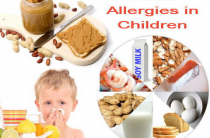The manifestation of symptoms of food allergies is caused by an increased sensitivity of the patient's immune system to those substances that are part of the foods eaten. The occurrence of food allergies can be associated with a wide variety of factors, including: hereditary predisposition, environmental conditions, antibiotics, etc.
One of the main culprits for the appearance of food allergies are various disorders of the digestive system. A variety of poisonings and other manifestations of food intolerance are mistakenly attributed to cases of food allergies. This is not true, because during an allergic reaction, the patient's immunity behaves aggressively in relation to safe food components. Most often, these are food proteins, as well as specific substances that make up products unfamiliar to us. The latter often include citrus fruits and other exotic fruits.
Skin symptoms
There are a number of standard skin allergies that may be present in different types of allergies. In practice, it looks like the reaction from the skin of people sensitive to drugs and food can be very similar.
During allergic reactions, the skin undergoes the following changes:
- Skin color begins to change noticeably. Most often, in places of allergic reactions, the skin turns red, but the appearance of purple, pink hues, and in some cases discoloration can also be observed.
- Various types of skin rash. Its nature and places of appearance depend on the specific skin-allergic disease that the patient suffers from;
- Edema appears on the skin, caused by the expansion of local vessels;
- The skin becomes dry, peeling appears;
- Most allergic skin reactions are accompanied by severe itching;
- Some allergic skin symptoms may leave scars.
As already mentioned, skin symptoms with food allergies can manifest themselves in different ways. Allergic reactions differ in the appearance of the rash, the speed at which it appears, and the symptoms that accompany them. With food allergies, skin-allergic reactions of such types as: urticaria, eczema, dermatitis and neurodermatitis are observed. The difference between these skin diseases is due to the fact that somewhat different mechanisms of the immune response are involved in their occurrence. This causes the difference not only in their appearance, but also in what treatment is taken to eliminate them.
Hives
Urticaria is so named because it is indistinguishable from those burns that one has experienced from close contact with nettle leaves. Symptoms of urticaria are easily recognizable, first of all, this is the appearance of formations on the skin due to rounded blisters. Their color can vary, occupying any shade from pale pink to deep red. Urticaria is an edematous reaction of the skin, so these rashes rise slightly above the general surface of the skin. Their size and location cannot be predicted. In some cases, this is a frequent accumulation of small rashes, and in others - large spots. The intensity can also be different, from several patches of just over a five-kopeck coin to extensive rashes all over the body. During urticaria, the patient can often find another unpleasant symptom in himself - this is severe itching throughout the body.
With food allergies, urticaria often occurs if the body has a sensitivity to foods such as: peanuts, shrimp, fish, hazel, strawberries, citrus fruits. Often, urticaria occurs with the use of various synthetic substances that are present in foods such as convenience foods, sugary drinks and factory juices, sweets and ready-made desserts.
Eczema
Eczema is a specific symptom of a food allergy that develops in stages. At first, redness appears, in places where the skin becomes dry and deep furrows appear, which have a significant depth and sharp outlines. Then the following transformations occur: a rash appears, which contains a large amount of tissue fluid. After a certain time, grooves form in the places of the rash, which secrete liquid contents.
Dermatitis
Dermatitis is a skin reaction that has complicated symptoms. It includes numerous skin manifestations:
- Redness of the skin. This is due to the expansion of the blood vessels of the outer layer of the skin, which occurs as a result of the immune response to the ingestion of a food allergen.
- Intense itching. With dermatitis, the nerve endings are largely irritated, so this symptom is often especially acute;
- Skin rash. With dermatitis, it is represented by formations in the form of small nodules, inside of which fluid is contained. In case of destruction, which can occur over time or under the influence of mechanical factors, the localization sites are covered with formations from dried liquid contents;
- Dryness and peeling. In places marked by the appearance of dermatitis, drying of the skin may be observed, accompanied by flaky small areas of the skin;
- The places of localization where the symptoms of dermatitis develop first of all are the face, as well as the areas of folds (elbows, knees, fingers).
Most often, with dermatitis, allergens are foods such as: fish, as well as other seafood, nuts (of all kinds), chicken eggs, cow's milk, celery, sesame.
Neurodermatitis
Neurodermatitis is a specific allergic rash that is directly related to nervous disorders. Basically, this relationship is manifested in the intensification of the symptoms of the disease under the influence of stress factors. To eliminate the symptoms of neurodermatitis in food allergies, it is of great importance not only to take measures to treat skin rashes, but also to eliminate stressful influences. Without these measures, treatment cannot be complete, and therefore effective.
Quincke's edema
Quincke's edema can only be partly attributed to the skin symptoms of food allergies. This is due to the fact that the skin is not the only organ that is involved in the acute processes that occur with this type of allergic reaction. In addition to the skin, mucous membranes and subcutaneous adipose tissue may also be involved. Quincke's edema develops in people whose immune system is prone to an immediate and acute response to a food irritant. With Quincke's edema, intense edematous phenomena occur in sensitive tissues. If there is swelling of the mucous membrane of the larynx, this phenomenon can be life threatening.
In addition to the symptoms of edema, there is also a deterioration in the general well-being of the patient, there are pains in the abdomen, a feeling of nausea, the patient may vomit.
Eyes, nose and respiratory system
The most common symptom of a food allergy in the respiratory system is swelling of the mouth, tongue, and a feeling of sore throat. Some of the allergens may begin to be absorbed already in the oral cavity, which makes it vulnerable to the influence of the allergen.
On the part of the organs of vision, the symptoms of allergy are manifested as follows: tears begin to flow intensively from the eyes, a runny nose appears, the mucous membrane of the eyes and adjacent skin are irritated, and redness is observed.
The patient notes pain and fatigue in the eyes, which adversely affects visual acuity. From the side of the nose, there is congestion, frequent clear discharge, irritation of the sinuses. This significantly prevents the patient from breathing, which is also not a favorable fact.
A severe bout of dry cough can also serve as a symptom of a food allergy.
If they appear before the rest of the symptoms, the patient may mistake them for symptoms of SARS. Gastrointestinal symptoms
Food allergies are accompanied by disorders of the gastrointestinal tract, which can be both its cause and effect. Pain in the stomach, nausea and vomiting, stool disorders (liquid content, constipation or vice versa diarrhea) are more common than other manifestations of the digestive system.
Pain, with food allergies, are in the nature of acute attacks that the patient may experience depending on the rate of entry of food components into the blood, which is due to the different composition of the products. The pain itself can be both intense and mild. Often, severe pain is manifested by short contractions, and weaker pain symptoms, on the contrary, are prolonged. During a food allergy, the appetite also suffers, which can weaken both in relation to certain foods and in general.
Food allergies are often accompanied by symptoms such as vomiting after eating. This reaction is due to the sensitivity of the sphincter, which closes in response to the allergen. In the vomit there is practically undigested food.
If the intestinal muscles begin to contract under the action of the allergen, the patient experiences constipation attacks. In contrast, frequent diarrhea can also be observed. At the same time, fatty secretions are present in the stool, which indicates a malfunction in the digestive system.
General health with food allergies
Symptoms of food allergies, in addition to special signs, also have an impact on the general well-being of the patient, which noticeably worsens when an allergen enters. Often you can find an increase in the overall body temperature, chills, nausea. Along with disorders of the gastrointestinal tract, digestion disorders naturally occur. Therefore, with a food allergy, the patient may experience symptoms such as weakness, deficiency of vitamins and minerals, and sudden weight loss. Headaches may be present. This issue is especially acute in cases where there is a violation of breathing, with inflammation of the nasal mucosa. Oxygen deficiency can also lead to perceptible weakness.
Food allergy symptoms are an extremely unpleasant phenomenon for the patient, which can significantly affect intellectual and physical performance.
Anaphylactic shock
The most formidable symptom, or rather their group, of all allergic reactions is anaphylactic shock. In a very short period, the development of acute and intense allergic reactions takes place. Their danger is so high that the life of the patient is in danger.
Manifestations of anaphylactic shock are very extensive. Their groups may vary from case to case. But still there are a number of main manifestations that remain unchanged. One of the most dangerous is a sharp drop in blood pressure, as a result of which blood does not flow to the vital organs in the required volume. The spasm of the muscles surrounding the larynx and bronchi is also of great danger. In this case, death can occur from acute oxygen starvation.
The first symptoms of anaphylactic shock in most cases are a feeling of weakness, which increases as anaphylactic shock develops. Urticaria may also occur, which quickly spreads throughout the body. Before the eyes of the patient, the rash becomes more and more widespread. There may also be attacks of pain in the lower abdomen, intense sweating, a fog appears before the eyes. Anaphylactic shock is accompanied by fever, chills, and anxiety. The patient's face is very pale, due to extremely low blood pressure.
The main thing, if you notice symptoms of anaphylactic shock in yourself or those around you, call an ambulance, with a quick and concise listing of symptoms. Before her arrival, the only thing you can do on your own is to remove the clothes that impede breathing and fill the room in which the patient is located as much as possible with air.















